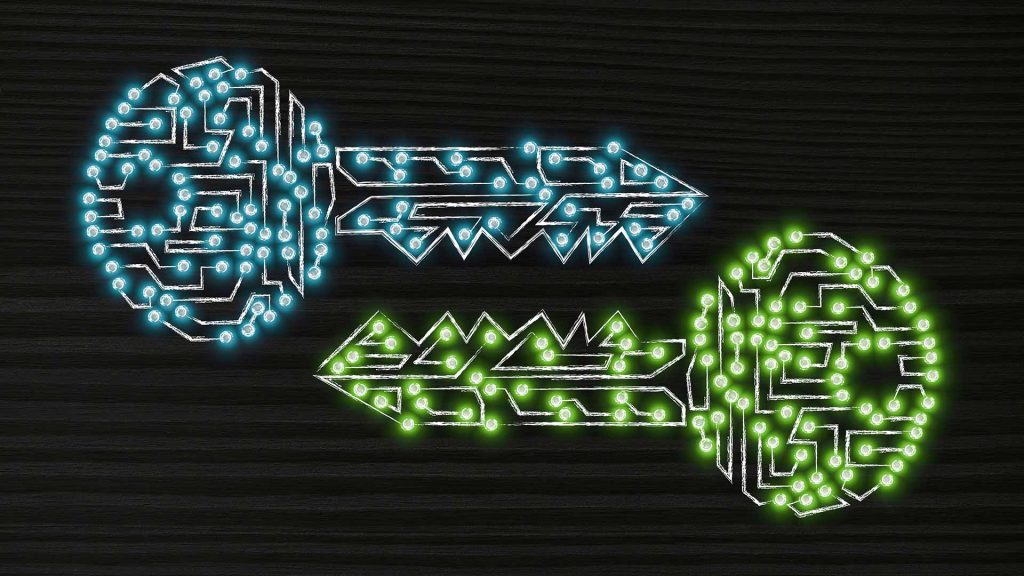Bitcoin’s technology is built on the blockchain, which is a decentralized database that is cryptographically secured. The cryptographic findings thus form the basis of Bitcoin. But what exactly is cryptography and what makes it so unlikely for the Bitcoin blockchain to be manipulated by hackers?
How Cryptography Came to Exist: The Desire for Secure Encryption
It is a very basic human need to have discreet channels of communication. In the context of oral communication, this is relatively simple: you entrust people with information that you are sure they will not pass on without your consent. If you entrust information to physical intermediaries, however – such as letters, telephones, e-mails – things become more difficult due to the third parties involved with these carriers. The sender wants to be sure that their information remains confidential.
Cryptography is a technology used to encrypt information, keeping exactly that which should remain a secret, a secret. This technology wants to make it possible for the sender of a message to determine who can read their message. This secrecy function should be technologically secured, not only morally or legally secured.
In the era of information technology – which is based on the networking of computers – cryptography proves an important application. When electronic messages and documents are sent, they travel through various channels on the internet. But are all of these channels reliable and discreet? Here’s where cryptography comes in; by using mathematical methods to encrypt sent content, cryptography aims to dispel any doubts pertaining to security or privacy. This has led to the development of tools that now also serve to protect the Bitcoin blockchain.
Asymmetric Encryption of the Bitcoin Blockchain
Cryptography for the Bitcoin blockchain uses complex and sophisticated mathematical methods – this is referred to as asymmetric encryption. The asymmetric encryption method uses two different keys: one for encrypting information and one for decrypting information. What’s special about this is that the key for encrypting is public; only the key for decrypting, known as the private key, is secret and individualized. This key is, for example, possessed by cryptocurrency holders so they can access their crypto. It consists of a combination of 78 characters and must be guarded very carefully. If lost, this key cannot be replaced by another – it’s impossible. In such a case, the currency units won’t disappear through theft or the like, but it will be (and remain to be) impossible for the holder to access them. The code is unbreakable.
For the BISON app, however, no private key is required. This is due to the fact that users’ cryptocurrencies are held on a fiduciary basis by blocknox GmbH, a company under the Stuttgart Stock Exchange Group. BISON app users only need their personal login data for trading and transferring Bitcoin (Crypto Out). So they use cryptography without having to worry about the complex operation and private keys behind it.
The Power of Mathematics: Bitcoin as Virtually Unhackable
Modern encryption methods, such as those used in the Bitcoin blockchain, are based on mathematical formulas. These can manifest a great deal of power. Specifically, this means that even if you have access to every computer on earth, it will still take several years to solve certain mathematical encryption puzzles. One example is factorization. Here, two very large prime numbers are multiplied by each other, let’s say 300 digits each. The product of this multiplication is, therefore, a correspondingly large number – the multiplication itself is relatively simple. The cryptographic riddle, however, is that only the product is known, while the two factors of the multiplication have to be calculated from it. This is almost impossible; it can only be calculated with inconceivable effort. According to Heise, the largest number for which a problem of factorization has ever been solved consists of 200 digits.
With the Bitcoin blockchain, there is only one way to illegally crack the cryptographic puzzle upon which the encryption is based – it can be done with what’s known as a brute force attack, i.e. “naked force”. This simply means attempting each and every possible solution. If one combination doesn’t work, you take the next one, calculating solutions and trying them all out. For the Bitcoin blockchain, however, this leads to an unbelievably large number of calculations.
Great deals of electrical energy would need to be used to power the computers solving the cryptographic puzzle at random. It’s safe to say that you’d need the energy of several suns, consumed over hundreds of years. This means that the Bitcoin blockchain is virtually unhackable by human standards. The power encompassed by the large numbers built into the blockchain’s encryption methods makes it almost impossible to crack.
Video on Cryptography from the Boerse Stuttgart
This episode from the video series Krypto-Update (with english subtitles), from the Boerse Stuttgart, deals with what are known as quantum computers. This extremely fast technology, whose development is still in its infancy, could be suitable for breaking the cryptographic encryption of the Bitcoin blockchain. Here’s an interesting interview that gives provides good insight into the power of cryptography.
